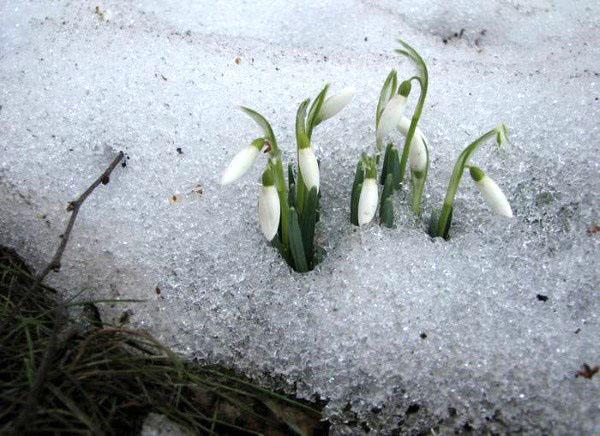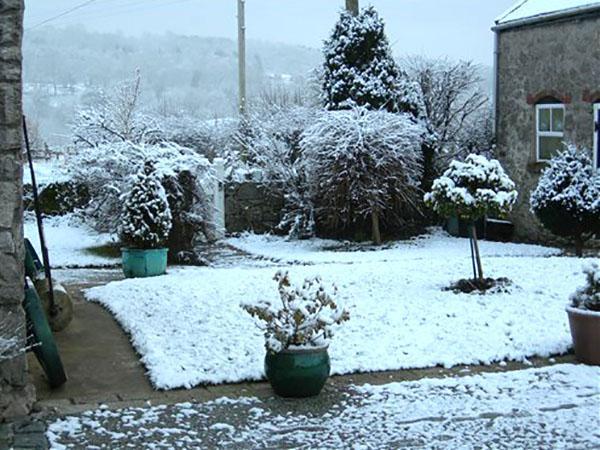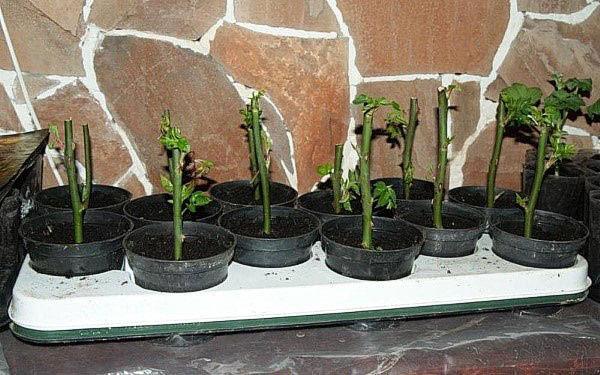March chores in flower beds: what to do with indoor and garden flowers
 With the arrival of spring, a hot season comes for flower growers: the sun shines brighter in the windows, it gets dark every day later, all plants begin to come out of their winter sleepy state and actively develop. In this regard, the summer resident has enough trouble in flower beds in March, from indoor plants to open field crops. What are we going to do first?
With the arrival of spring, a hot season comes for flower growers: the sun shines brighter in the windows, it gets dark every day later, all plants begin to come out of their winter sleepy state and actively develop. In this regard, the summer resident has enough trouble in flower beds in March, from indoor plants to open field crops. What are we going to do first?
The first exit to the flowerbed

The beginning of March for most regions is no different from winter weather: the snow cover hides all the flower beds and beds underneath, and the frost still does not want to retreat. Of course, in such conditions it makes no sense to talk about working on the street, but the weather is an aunt with a changeable character, moreover, in the southern strip in the month of March, snow is often no longer found.
If you are lucky enough to live in such places, when all the snow cover has melted on the flower bed, and the soil has dried out, we wait for a sunny day, dress warmer, take a pruner and gloves, and go for a walk. With a fan rake, so as not to dig deep into the ground and damage perennials that have not yet emerged, we carefully rake the foliage and debris - when it dries, it will be possible to burn it, and use the ashes to fertilize the flowers when planting. We also trim the bushes of perennial asters and chrysanthemums.
When cleaning a flowerbed, we carefully look at our feet, especially if snowdrops are planted there: fragile peduncles can sometimes be hidden under old dry leaves and can be trampled.
We prepare planting material for a flower bed with roses
 In March, we look into the rose garden: it's too early to start pruning the bushes, but it's already quite possible to harvest cuttings if the winter was not very cold. We select non-frozen twigs with clear signs of swollen living buds and cut them off with a sharp one secateurs... It is better to take shoots, the thickness of which is slightly larger than a pencil - there are fewer nutrients in thin branches. The length of the cuttings cut in spring should be longer than during autumn cuttings, and be at least 20 cm. They can be rooted first in water with further transplantation, or immediately in nutritious soil.
In March, we look into the rose garden: it's too early to start pruning the bushes, but it's already quite possible to harvest cuttings if the winter was not very cold. We select non-frozen twigs with clear signs of swollen living buds and cut them off with a sharp one secateurs... It is better to take shoots, the thickness of which is slightly larger than a pencil - there are fewer nutrients in thin branches. The length of the cuttings cut in spring should be longer than during autumn cuttings, and be at least 20 cm. They can be rooted first in water with further transplantation, or immediately in nutritious soil.
It is worth noting that climbing and some varieties of hybrid tea roses, as well as floribunda, propagate best by cuttings, but cuttings of a wrinkled park rose and most varieties of yellow-flowered roses are extremely reluctant to root.
We check the garden flowers in storage
 If in February there was no free time to inspect the tubers of plants dug out for the winter and stored indoors, in March we take out flowers and carefully examine them. We select and discard rotten tubers, and those that have the first signs of the disease are cleaned and disinfected.
If in February there was no free time to inspect the tubers of plants dug out for the winter and stored indoors, in March we take out flowers and carefully examine them. We select and discard rotten tubers, and those that have the first signs of the disease are cleaned and disinfected.
 At the end of the month, some of the overwintered crops can already be placed in pots of wet sand for germination, for example:
At the end of the month, some of the overwintered crops can already be placed in pots of wet sand for germination, for example:
- tuberous garden begonia;
- dahlias.
We start growing flower seedlings
 Like gardeners, florists also have a lot of March hassle in flower beds associated with seedlings. The seed method of growing is one of the most popular: it allows you to easily get new varieties of perennial plants into your collection, as well as to grow annuals.
Like gardeners, florists also have a lot of March hassle in flower beds associated with seedlings. The seed method of growing is one of the most popular: it allows you to easily get new varieties of perennial plants into your collection, as well as to grow annuals.
One of the advantages of the seedling method is that the plants obtained in this way bloom much earlier than those that were sown directly into the open ground.
From about the second decade of March (depending on the specific growing region and its climatic conditions), you can sow the following crops on seedlings:
- ageratum;
- Chinese aster;
- dope;
- petunia;
- Chinese carnation;
- lobelia;
- verbena;
- sweet pea;
- Waller's balsam;
- garden tradescantia;
- marigold and many other flowers.
Spring chores with indoor plants
 Whoever has spring in full swing, even despite the snow and frost outside the window, is the flowers growing in pots on the windowsills. It is with such crops that flower growers have the most trouble in the month of March. With the beginning of the growing season, we arm ourselves with sharp scissors and proceed to pruning:
Whoever has spring in full swing, even despite the snow and frost outside the window, is the flowers growing in pots on the windowsills. It is with such crops that flower growers have the most trouble in the month of March. With the beginning of the growing season, we arm ourselves with sharp scissors and proceed to pruning:
- pelargonium;
- hibiscus;
- Kalanchoe;
- azalea;
- balsams;
- indoor evergreen boxwood and other plants that need annual trimming.
Pruning will not only stimulate the branching of plants and the formation of flower buds, but also help to give them a compact shape.
In addition, it is time to plant and awaken from hibernation cultures with a pronounced dormant period, such as gloxinia, amaryllis, achimenes and similar plants.
 One of the main spring procedures is flower transplantation. We stock up on fresh nutritious soil and flowerpots and go to check our flower holdings: we transplant the bushes that have clearly outgrown their pots into more spacious containers. The transplant can be combined with plant propagation. Also, from March, we begin to slowly feed the window sill pets, helping them to build up the deciduous mass and tie the buds.
One of the main spring procedures is flower transplantation. We stock up on fresh nutritious soil and flowerpots and go to check our flower holdings: we transplant the bushes that have clearly outgrown their pots into more spacious containers. The transplant can be combined with plant propagation. Also, from March, we begin to slowly feed the window sill pets, helping them to build up the deciduous mass and tie the buds.
As you can see, the hassle in the month of March with flower beds, including window sills, is enough, but it's worth it, because with proper care, both indoor and outdoor plants will delight with abundant flowering to the envy of neighbors and to their delight.